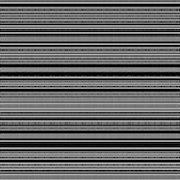In Tyler Hubby’s illuminating 2016 documentary, Tony Conrad: Completely In The Present, there is a moment where the late musician speaks about his early work and declares: “I wanted to end composing, get rid of it. I wanted it to die out.” Conrad’s approach to composition consisted of a few simple, but acute directions. His collaborative album with Faust, Outside The Dream Syndicate, was composed according to a simple event score: one note, one beat, one hour. This approach developed from Fluxus, the neo-Dadaist art movement that preferred playful concepts to painterly expressionism. Conrad’s ‘minimalist’ aesthetic, as well as his sentiment about authorial death, resonate strongly in D Glare’s latest release for Opal Tapes, 4 Oscillators And 130 Samples At 130 BPM.
For starters, the album is presented as a four-sided cassette multiple, complete with schematics, while the title itself reads like a Fluxus event score. We are given three key parameters within which the music operates: copious sound sources, four objects that manipulate these sounds and a rhythmic, temporal dimension. The rest are variables. A combination of filters, distortion, tape, phase, reverb, EQs and tuned feedback all serve to modulate the 130 ‘found sounds’. Aligning the album’s samples with the ‘found object’ allows D Glare to sculpt new structures out of the source material without oversaturating the sonic field. This is achieved via the means of a detached regimen, mediated by technology and chance operations. (Each track was improvised and recorded live, without editing.)
D Glare’s previous work, with the Leeds-based techno duo Chrononautz, approached music making with the same conceptual fervour. Their 2015 album, Noments, derived from a series of improvised sessions, which were heavily influenced by a comprehensive hardware setup and “fumes from the car re-spray garage beneath” their studio. The result was a compelling and informative chaos. Noments was followed by D Glare’s first solo record, 68 Samples At 68 BPM For Phased Heads, which built on the desire to explore self-imposed limitations.
While 68 Samples best resembles James Ferraro’s scintillating digital atmospheres, by contrast, 4 Oscillators acts like a vacuum. The beats, bass and synthesisers all conspire to create a claustrophobic density through a series of evolving minimalist sequences.
The final minutes of Side B, for example, evoke an eerie sensation, as if the intercutting melodies were really ghostly afterimages of themselves. They are condemned to an intestinal pulsating ether. Just how long they will be forced to stay in this purgatory is unknowable, and this lack of certainty causes them to wail in anxious agony. Occasional synthetic strings nod towards Mica Levi’s indelible soundtrack for Under The Skin, but where Levi succeeded in building up an insufferable tension through discipline and restraint, D Glare’s Side B offers up a relentless attack on the senses and little reprieve.
This observation holds true as we flip over to the following side. Promises of slow, acousmatic explorations quickly dissipate into twisted ankle 2-step, dirty Slimelight grooves and laser beams. Sonically, D Glare has little in common with Tony Conrad – other than sharing a love for rules and perpetuity – but if Conrad is the minimalist equivalent of dipping your toes in a river, then D Glare’s 4 Oscillators is a collapsing jetty at high tide.
Immersion is a word too-readily thrown about in music criticism, especially in discussions around psychedelia. It is certainly applicable in this instance, but what is important to note is that D Glare’s immersion is not at all ‘womb-like’, warm or friendly. Rather, it suggests the oneiric underworld of sleep paralysis: dreams where the body is immobile, intruders stand by your bedside and breathing is nigh on impossible.
In other words, 4 Oscillators is ripe with elemental, insatiable drama. But drama is all too often mistaken for conflict and this album is far too confrontational to be confined to the album format alone. Its duration, which clocks in at 120min, is double the length of a standard attention-friendly long player. Instead, it suggests a more elaborate, permanent staging. For example, a gallery setting – where one’s active listening could be encouraged with additional multimedia elements (as exemplified by La Monte Young’s Dream House) – would undoubtedly prove to be more appropriate for a record of such ambitious scope.


